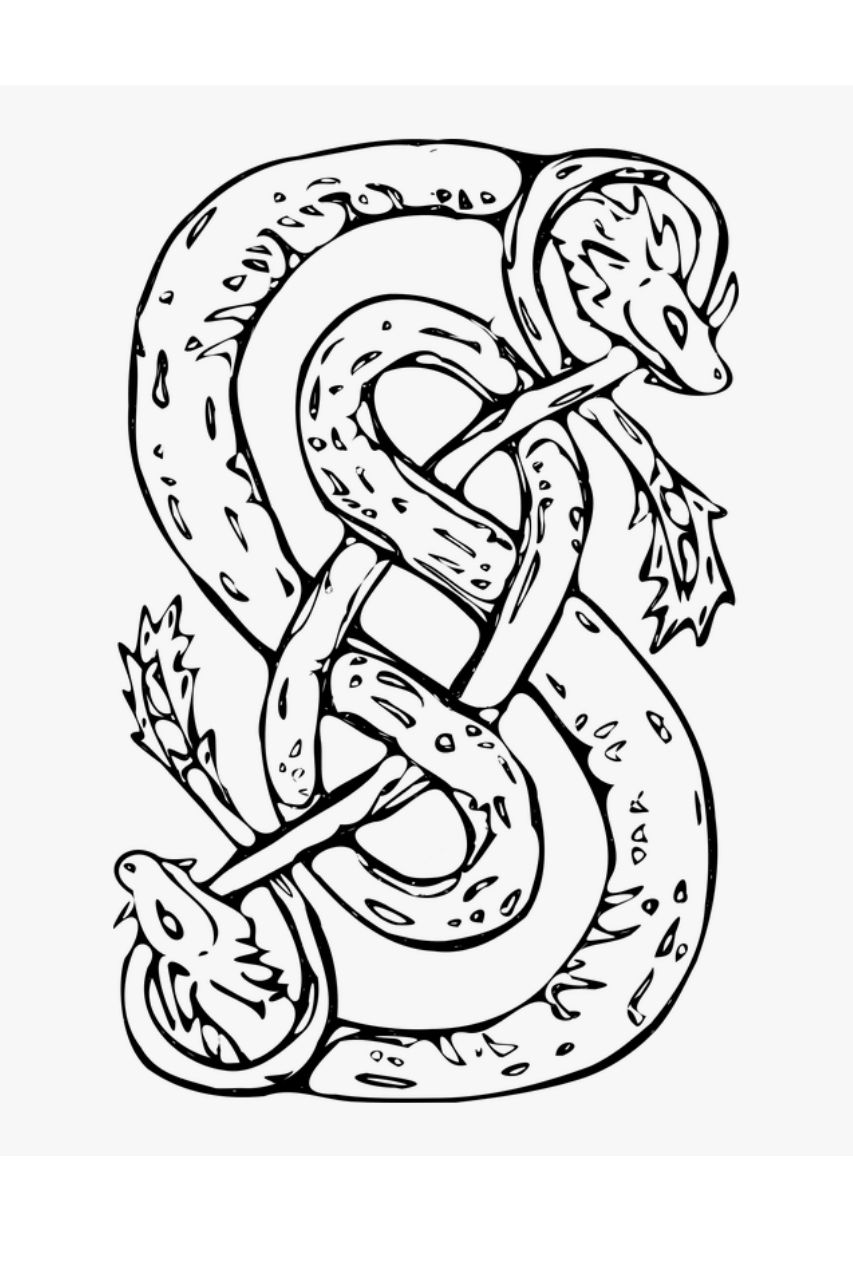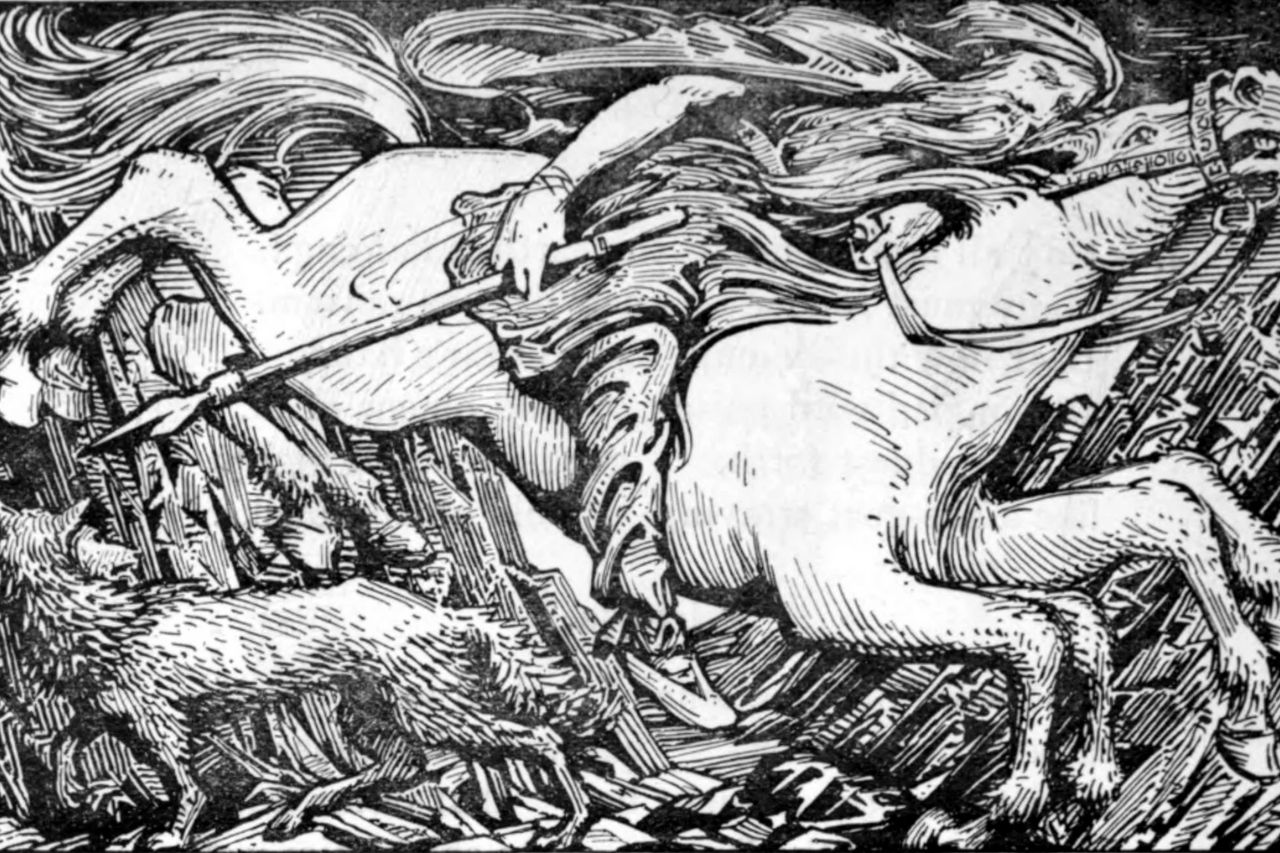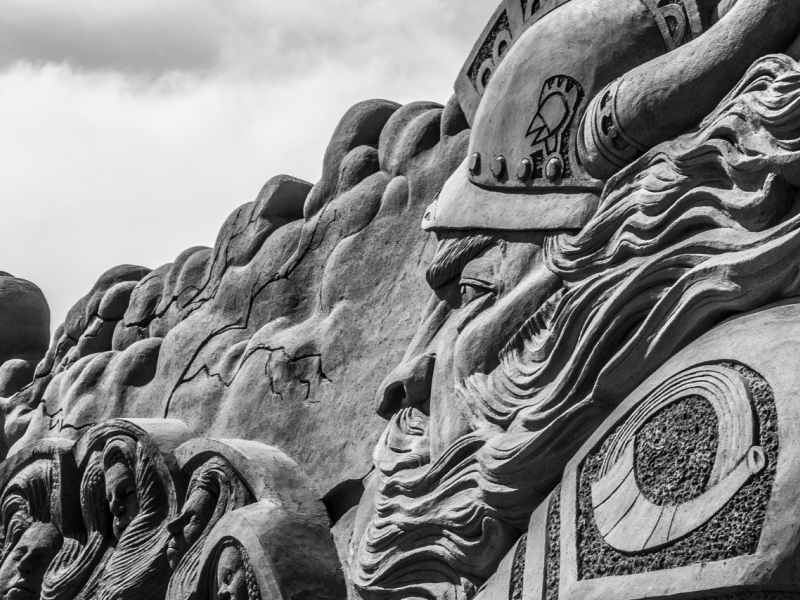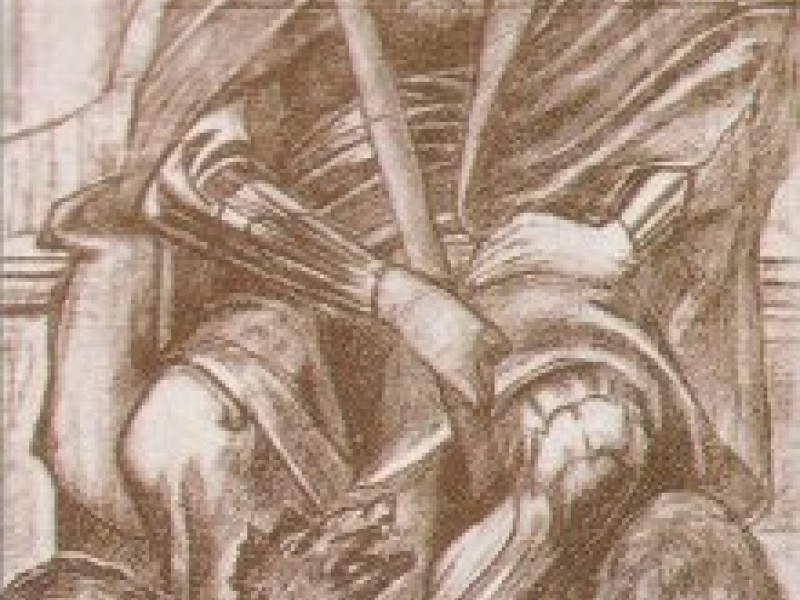Loki
Loki: More Than the Norse Shapeshifter in Marvel Movies
Loki, the god of mischief and trickery in Norse mythology, was probably the most devious character. He was one of the gods, yet he sought to undermine them any chance he got, just for the chance to do some of his tricks. He was involved in multiple myths, and he always added a bit of interest. Read on to find just what kind of trouble he got himself into time and time again.
Who Was Loki in Norse Mythology?
The trickster god of mischief in Norse mythology, Loki was part of the Aesir tribe along with famous gods such as Thor and Odin. The Aesir tribe was dedicated to order and justice, but paradoxically, Loki cared more about his trickery than anything else. Loki's shapeshifting could turn him into various things, but Loki’s true form was as a god.
Loki was a confusing character because he sometimes went against the gods, but sometimes he helped get them out of bad situations. Even at the end of days, or Ragnarök, it was predicted that Loki would fight against the gods in the final battle. He was neither good nor evil, really, and his only aim was to put things into chaos. In that respect, he was very much like other trickster gods from various mythologies.
Going by the Old Norse, Loki’s name meant “fire,” but in the old Germanic language, it meant “knot/tangle.” Either word makes sense because fire is frightening and unpredictable, and a knot/tangle causes frustration. Loki did both, and he took pleasure in doing so. But he carried no weapons, and he didn’t always intend on real violence.
Origins: How Was Loki Born?
It’s not clear how exactly Loki was born, and there isn’t much detail on Loki’s parents. But his father was a jötunn, or creature named Fárbauti. His father’s name meant “cruel striker.” Loki’s mother was named Laufey in most records, who was mentioned in records as a goddess.
Family of the Trickster God
Through the same number, Loki had two brothers named Helblindi and Býleistr. Loki did marry, even though the wife was not mentioned very much in mythology. Loki’s wife was Sigyn, and she was also a goddess. Together they had a son named Nari or Narfi.
But like so many other gods, Loki had affairs with other deities. He also had affairs with other jötnar in which children were produced. With one of his mistresses, he had his most famous children. Loki’s children were:
Hel, the goddess of the underworld
Fenrir, the wolf, whose destiny it was to kill Odin at the end of days
Jörmungandr, a sea serpent who was Thor’s worst enemy
Myths of Loki, the God of Mischief
Loki participated in so many myths because he always tried to use his trickery. He either would help the gods or try to thwart them in some way. Loki’s myths were mostly recorded in Snorri Sturluson’s collection of Norse myths. Sturluson was a 13th-century Icelandic scholar who wrote down many Norse myths, and they’re a wonderful source we use even today.
Loki and His First Trick
One day, Loki was feeling ready for a trick, and he decided, inexplicably, to cut off all the beautiful blonde hair of Sif, Thor’s wife. Thor, the god of thunder and known for his anger and violence, flew into a rage and threatened to hurt Loki. Loki placated Thor by promising to visit the dwarves to get them to make a hair replacement for Sif. He traveled to the realm of dwarves, also called Svartalfheim, and he asked them for a new set of hair.
He went to the sons of Ivaldi, who were known for excellent craftsmanship, and he made this request of them. They did what he asked, but they also made a special ship called Skidbladnir, which could sail no matter the weather and could fit into a pocket. Not only that, but they built Gungnir, a very powerful spear. Loki had made a success of making up for his mistake, but he couldn’t resist another chance of stirring up trouble.
He found another set of craftsmen named Brokkr and Sindri, and he told them they couldn’t possibly make anything as good as the Ivaldi brothers. These two brothers took it as a challenge, and they worked hard to make something just as good; and Loki transformed into a fly and bit them as they worked. But in the end, they made Gullinbursti, a mechanical boar who glowed in the dark; Draupnir, a gold ring, and Mjölnir, the hammer that made Thor famous.
Loki and the Ultimate Roast
Loki was in an angry mood one day, and he was enjoying the festivities in the hall of Aegir, a certain god of the sea. They gave compliments and praises to Aegir’s servants, who were named Fimafeng and Eldir. For whatever reason, Loki didn’t like all the praise that was being heaped on the servants, and he ended up killing Fimafeng. Loki wasn’t usually so violent, but in this case, he was.
All the gods who were present were furious, and they fought against him, getting him to go outside. But after that, everyone started hurling insults at one another, which was called a flyting. During this time, Loki thought of an insult for each and every one of the gods. He told Frigg, Odin’s wife, that she was sleeping around.
He told Freya that she was a witch and that she’d slept with her own twin brother Freyr. He even insulted Thor and Odin, which was a risky thing to do. When the gods got enraged and threatened to come after him again, he turned himself into a salmon. He jumped into a river and swam to safety.
Loki Finds Thor’s Hammer
While some tales showed the bad side of his personality, there were others that showcased a more helpful side. One day, Thor woke up, and he realized that he couldn’t find his hammer; it was nowhere to be found. He rushed to the gods for aid, and they told him they also didn’t know where it was. Loki set off to find the hammer for Thor, and he used Freya’s falcon feather cloak to do it.
Freya’s cloak would give any wearer the ability to fly, and Loki flew in search of the hammer. He flew to Jötunheimr, which was one of the nine realms in the Norse world, and the realm of the creatures or jötnar. It was there that he found Thrym, the king of that realm, and he asked him about the hammer. Thrym laughed and told him that he took it and hid it away.
However, he was willing to return it to Thor under one condition. He wanted Freya, goddess of love and beauty, to be given to him as his wife. Loki returned home with the news, and the gods were furious. But Heimdall, one of the sons of Odin who had incredible eyesight had a rather unique suggestion.
Loki and Thor Go Crossdressing
Heimdall’s plan was that Thor should go to Thrym’s castle and pretend to be Freya. They would pretend to go through the marriage, and then Thor would reveal himself at the right time and get his hammer back. Thor reluctantly agreed, and he was dressed as a bride with a veil over his face. Loki dressed up as his maidservant, and together they traveled back to Thrym, hoping that their plan worked.
Thrym was overjoyed that his bride had agreed to come, and he welcomed him and his maidservant, and he served a great feast. Thor, being who Thor was, was able to devour a massive amount of food, including a whole ox. Thrym thought it was strange that his beautiful bride could eat so much, but Loki gave him an explanation about it, and he was satisfied. Once he was drunk enough, Thrym hoped to kiss his new bride, and he almost lifted the veil.
But Loki stopped him and said they wanted to go through the wedding ceremony as quickly as possible. Thrym agreed, and the ceremony began. When he brought out the hammer to seal the ceremony, he laid it on Thor’s lap, and then all hell broke loose. He stood up and slew everyone at the wedding and returned to Asgard with his hammer.
Loki Turns Into a Horse
In another tale, a giant approached the gods, and he offered to build up their castle as Asgard to protect them from attacks. They agreed, but the giant had his condition. He wanted the sun, the moon, and he wanted Freya’s hand in marriage just like Thrym had done. The gods thought about it, and they decided to agree, but they had a condition of their own.
They said that the giant could have all these things if he was finished building by the first day of summer. The giant said that would be fine, but he would need to use his horse, named Svadilfari, to help him do the building. The agreement began, and the builder started the work. Things were going well, and the gods started to get nervous because the giant was on time with all the buildings.
But the giant was depending very heavily on his horse to help him with the work, so Loki had an idea. In this case, Loki helped the gods because the gods were very worried that they’d lose Freya to a giant. He transformed himself into a mare, and he lured away the giant’s horse with seductive methods. Because of that, the giant couldn’t finish his work, and he was furious that he was inhibited in completing his work.
Loki Gets Pregnant and Thor Is Called in
After that, the giant flew into a dangerous rage and tried to fight the gods for getting in his way. Like so many other times, they called upon Thor to help those who were away fighting other creatures at the time. When Thor came, he killed the giant right then, and the fight was finished. But Loki and the horse slept together, and Loki, still transformed as a horse, became pregnant.
Loki eventually had the baby horse, which was Sleipnir. This creature was the famous eight-legged horse, and it became Odin’s favorite and his traveling companion.
Loki, the Tattletale
Christian priests wrote this particular story in the 14th century, so they may have been trying to discredit the Norse gods. It was about Freya, who, in this tale, was Odin’s lover. One night, when she left Odin, she traveled to the realm of dwarves, and she saw them making a beautiful necklace. She loved the necklace so much, and so she asked the dwarves how much they wanted for it.
They told her they had a price, but it was for her to have sex with them. It was a high price, but she agreed to sleep with them and got the necklace in the end. Happy with her prize, she returned home, and Loki found out about it. Loki and Odin discussed it, and Odin told him to bring him the necklace.
Loki transformed himself into a flea, and during the night, he flew into Freya’s bedroom. She was sleeping on top of the necklace when he arrived, so he had to bite her to get her to turn over. When she did, he grabbed the necklace and took it to Odin. When Freya saw Odin again, she told him that her necklace was gone, and he accused her of infidelity.
The Bad Ending
He said that he would give her the necklace back if she would be able to force two kings to start fighting. Each of those two kings had 20 kings under them, and Odin wanted them to fight an endless war. Freya was able to do it, but it was ended when a true Christian took the Norse throne. The Christians added it to make a sort of transition from the old ways of Norse mythology to the new Christian stories.
In this way, they were able to discredit Loki, Odin, and Freya. They made them look worse than maybe they actually were in the original stories.
Death of Baldur: Loki Suffers the Consequences
One of the saddest and most famous stories in Norse mythology is the death of Baldur, the most beautiful god in the pantheon. He was sometimes called “Shining Baldur” because he had a luminescent quality, and he was beloved by all. Baldur was the son of Odin and Frigg, and he was Frigg’s favorite out of all her children. One night, Baldur had a nightmare that he was going to be killed, and when he went to his mother, he found out that she’d had the same dream.
Terrified, Frigg told Odin to go to the underworld to seek out a seer to see if their dreams were true. Odin did, and when he spoke to one inside of the underworld, he found out that their dreams were spot on. Baldur was going to die, and Odin returned to tell his wife the terrible news. Frigg had some magical powers of her own, so when she heard this, she made all living things swear that they would not hurt her son.
Everything did, so Baldur was free from everything like metal, water, poison, and more. One day, Baldur’s brothers were playing with him, throwing things at him and trying to kill him to prove that he was unkillable. Loki saw what was going on, and he asked Frigg if there was truly nothing that could kill her son. She told him she had asked for this promise from all living things except mistletoe because it was so harmless.
Loki Puts His Plan in Motion
Once Loki heard this, he had an awful, evil idea. He decided to pluck a sprig of mistletoe and fastened it to the end of a sharp spear. While the brothers were still throwing things at Baldur, he handed this spear to Hodr, Baldur’s blind brother. He told him to throw it at Baldur, and Hodr did, but the spear sunk in because of the mistletoe this time.
Baldur lay bleeding upon the ground, and Loki ran away. Odin leaned down to whisper something in his son’s ear, but no one knew what it was. It is one of the great mysteries of Norse mythology. Baldur’s family was furious and grieved, and Frigg asked for anyone who would go to the underworld to ask if they would give her son back.
Hermod, one of Frigg’s other sons, volunteered to go, and he traveled there to meet Hel, the goddess of the underworld. She told him that Baldur could go back to the land of the living, but every living thing on earth had to grieve for him to prove that he was so well-loved. Hermod returned to the family and told them what to do. They all set to work to get everything to show their grief and cry for Baldur to get him to return, but Loki also put a wrench in these plans.
Loki Refused to Cry
The gods were going around to ask everyone to cry, and they came upon a giantess named Thökk. This was really Loki in disguise, trying to keep out of the gods’ way. When they asked him to grieve for Baldur, he refused, and thus Baldur was banished to the underworld for eternity. When they realized that his spirit was gone forever, they sent his body out on his boat and set it alight.
Odin had a child with a giantess, and his name was Váli, and he grew up in one day. He hurried off to kill Baldur’s brother, Hodr, for his involvement in Baldur’s death. But when the gods found Loki, they gave him a terrible punishment. Loki’s punishment was that they put him against a pile of boulders, and they tied him there with the entrails of one of his sons.
They even placed a snake above his head, which would drip down venom upon his skin. It would cause him to shake in agony. He writhed with such violence that it was the cause of earthquakes in Norse mythology. Loki was meant to remain in this tortured state until the end of days when he would be free again to join the final battle.
How Did Loki Die in Norse Mythology?
During Ragnarök, the gods were prophesied to fight a battle against the jötnar. Gods that were dead would be resurrected, and in Loki’s case, the gods who were trapped or imprisoned were released. Because of his anger against the gods, Loki joined the side of the jötnar in fighting against them. His children, like the serpent and the wolf, also took part in the battle, killing very important gods.
Loki was prophesied to turn himself into a seal and fight the god Heimdall, and both would die.
What Was Loki’s Symbol?
Loki’s symbols could be many things such as knots, knives, falcon feathers, horses, wolves, snakes, and shapeshifting creatures. Anything to do with chaos or trickery could be Loki’s symbol.
Loki in Pop Culture
The most recent representation of Loki came in the Marvel movies played by the actor Tom Hiddleston. According to the films, though, Loki was Thor’s half-brother and the adopted child of Odin. He was always jealous of Thor, and he always tried to undermine him and the other gods, like his mythological persona. Loki’s sister exists in the films but not the mythology. He also was a shapeshifter in the movies and one of their main villains.
Conclusion
Take a look at the main points covered in the article above about the trickster god Loki:
Loki was the god of mischief in Norse mythology. He was not really good or evil, but his main focus was to cause chaos and destruction
Even though other characters in Norse mythology were trickster gods, Loki was the main trickster god. Sometimes, and randomly, he would be helpful, but he would usually find a way to fit a trick in there somehow
Loki could shapeshift, which was his main weapon. He didn’t really carry other weapons, but he used many tools, such as Freya’s falcon cloak, to help him achieve his ends
Depending on what language you look at, Loki’s name meant either “fire” or “knot/tangle,” which made sense because fire is unpredictable. And Loki’s actions would often cause frustrating knots or tangles in the gods’ lives
Loki’s birth wasn't really mentioned, but his father was a jötunn or creature, and his mother was a goddess. He had two other brothers named Helblindi and Býleistr
Later, Loki married Sigyn, another goddess. But not much is known about her, and together they had a son named Nari or Narfi
His most famous children are Fenrir, the wolf, Hel, the goddess of the underworld, and Jörmungandr, a sea serpent
In his first story, he cut off all of Thor’s wife Sif’s hair, making Thor furious. Loki said that he’d go to Svartalfheim to get her a new set of hair
He asked the Ivaldi brothers to make him the hair. They also made him other gifts such as a very special, fast ship and a powerful spear
Loki, feeling the urge to trick, offered a challenge to another set of dwarf brothers. He told them they could never make as good of weapons
They took the challenge and made three things: Gullinbursti, the mechanical boar who was speedy and glowed in the dark; Draupnir, a gold ring that could beget other rings, and Mjölnir, Thor’s famous hammer
In another story, at a feast, Loki was jealous of the man who owned the hall, praising his servants. He killed one of them, and the gods got angry
He began to insult them all before turning himself into a salmon to swim away from the furious gods
In another story, Loki was helpful. Thor woke up without his hammer, and Loki flew away with Freya’s falcon cloak to find it
He found out that Thrym, the king of the creature world, had it. And he said that he’d give it back if he could have Freya for his wife
The gods decided to send Thor and Loki dressed as women to Thrym
Thor dressed up as Freya, the bride, and Loki was his handmaiden
Thrym was all too delighted, and when they began the ceremony, he laid the hammer on his knees to seal the deal. Thor then revealed himself and killed everyone at the wedding
In another myth, a giant approached the gods, offering to build them a great, impregnable fortress. They agreed, but the giant said he would do it for the sun, the moon, and Freya as a wife. He wanted to use his horse to help him with his work
The giant worked well, too well, and Loki got involved to stop him from finishing by turning himself into a horse to seduce the giant’s horse, stopping his work
The giant was furious, and he flew into a rage because he didn’t finish. The gods called Thor to help them, and he came and killed the giant
Loki, still transformed as a horse, became pregnant, and the foal he bore became Sleipnir. This was the eight-legged horse that became Odin’s favorite and also his traveling companion
In another myth by Christian priests, Loki found out that Odin’s lover Freya cheated on him with a group of dwarves she slept with for a necklace
Odin told him to get the necklace, and he transformed into a flea and stole her necklace
Odin accused Freya, and he said he’d only give the necklace back if she was able to get a certain two kings to start fighting evermore
The fighting only ceased when the first Christian king sat upon the Norse throne
Loki’s worst and most famous myth is probably the death of Baldur
Baldur, the favorite and most beautiful of all the gods, dreamed that he was to die, and his mother, Frigg, did as well
Odin went to Hel to see if the dreams were true
He found out they were, so Frigg used her magic to try and protect him from every living thing. But the only living thing she didn’t ask for protection from was mistletoe
Loki found this out, and one day, when Baldur’s brothers were teasing him by trying to “kill” him with weapons, but of course, the weapons couldn’t injure him
Loki tied a bit of mistletoe to the end of a spear and asked Baldur’s blind brother to throw it at him. The brother did and Baldur died
Everyone was grieving, and Heimdall traveled to the underworld to get Baldur back
Hel agreed to give him back if everything grieved on earth for Baldur. They tried, but Loki, disguised as a giantess, was the only living thing who refused to grieve, and thus Baldur was lost to them forever
As punishment, Loki was tied to a rock with his son’s entrails. A venomous snake hung above him and poured venom on his skin
He was to remain there until the end of days when he would turn into a seal, fight Heimdall, and they would both die
Loki has most recently been seen in the Marvel movies. There are a few changes they’ve made to the original story. But the basics remain true: he was a shapeshifter and trickster through and through
Each mythology around the world seems to have that one trickster god who can’t seem to help themselves from throwing a wrench into the works. Loki is no exception, but it’s curious why mythologies tend to have this kind of figure. Maybe it’s a way to represent an agent of chaos, which is really life itself. Things are never predictable, and Loki was just a manifestation of that annoying and frustrating bit of chaos.












